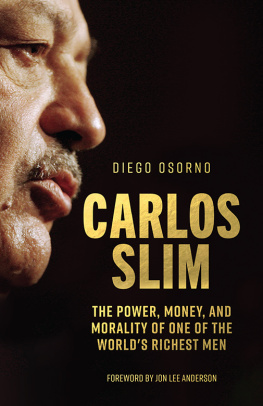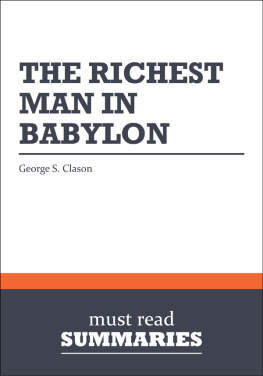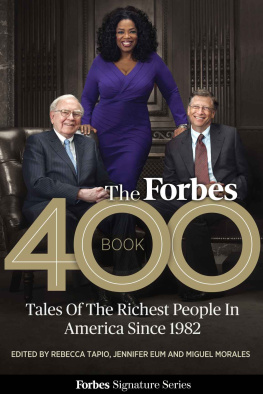Contents

Carlos Slim
Carlos Slim
The Power, Money, and
Morality of One of the
Worlds Richest Men
Diego Enrique Osorno

This English-language edition published by Verso 2019
Originally published in Spanish as Slim: Retrato del hombre ms rico del mundo
Diego Osorno 2016, 2019
Translation Juana Adcock 2019
Foreword Jon Lee Anderson 2019
All rights reserved
The moral rights of the author have been asserted
1 3 5 7 9 10 8 6 4 2
Verso
UK: 6 Meard Street, London W1F 0EG
US: 20 Jay Street, Suite 1010, Brooklyn, NY 11201
versobooks.com
Verso is the imprint of New Left Books
ISBN-13: 978-1-78663-437-5
ISBN-13: 978-1-78663-435-1 (UK EBK)
ISBN-13: 978-1-78663-436-8 (US EBK)
British Library Cataloguing in Publication Data
A catalogue record for this book is available from the British Library
Library of Congress Cataloging-in-Publication Data
Names: Osorno, Diego Enrique, 1980- author.
Title: Carlos Slim : The Power, Money, and Morality of One of the Worlds Richest Men / Diego Enrique Osorno ; translated by Juana Adcock.
Other titles: Slim. English
Description: Brooklyn, NY : Verso, [2019] | Originally published in Spanish as Slim: Retrato del hombre mas rico del mundo.
Identifiers: LCCN 2019017201| ISBN 9781786634375 (hardback : alk. paper) | ISBN 9781786634368 (US ebk)
Subjects: LCSH: Slim, Carlos, 1940- | Telefonos de MexicoHistory. | BusinessmenMexicoBiography.
Classification: LCC HC132.5.S55 O85313 2019 | DDC 384.6092 [B] dc23 LC record available at https://lccn.loc.gov/2019017201
Typeset in Sabon by MJ & N Gavan, Truro, Cornwall
Printed and bound by CPI Group (UK) Ltd, Croydon CR0 4YY
To Daniel Gershenson, Cuauhtmoc Ruiz and Andrs Ramrez
In memory of Conrado Osorno
All power is a permanent conspiracy.
Balzac
Contents
Since the beginning of his reporting career, Diego Enrique Osorno has dedicated himself to some of Mexicos thorniest issues, covering everything from the Zapatista insurgency and narcotrafficking to the migrant traumas along the northern border with the United States. For the past fifteen years, his books, articles and documentaries have positioned him at the forefront of his generation and earned him wide public recognition and the respect of his peers. Thats because Diego always delves deeply into the issues he tackles, and he reports them firsthand. He is brave. If you are a Mexican journalist, its dangerous to write about drug cartels and police corruption, and Diegos investigations into the Sinaloa and Los Zetas cartels, among other stories, are evidence of his determination to push the boundaries.
Diego Enrique Osorno was born in the northern Mexican city of Monterrey in 1980. When I first met him, more than a dozen years ago, he was still in his mid-twenties, and had just come out of a dramatic experience in Oaxaca, in southern Mexico, where months of protests by teachers had turned bloody as the authorities had responded with a brutal crackdown. Diego said that he felt as if he had been living in a war zone, and when he told me what he had lived through and witnessed, I agreed with him. More than twenty activists had been killed during the time he was there; others had been detained, tortured and some of them forcibly disappeared. Diego had also been an eyewitness to the shooting deaths of several men, including a Mexican mechanic named Jos Jimnez Colmenares and an American cameraman named Brad Will, and he had been left shaken and indignant from the experience.
What came next was a profound learning experience for Diego. As he followed up on the abuses he had discovered in Oaxaca, seeking justice, Diego did not find it. Instead, as is so often the case for those seeking redress for political crimes in Mexico, he encountered official obfuscation and impunity. Diego did not let go, however, but dug in deeper and eventually wrote his first book, Oaxaca Besieged, about the episode. Over the years since then, Diego has reported on a wide range of other issues, with the topic of injustice foremost in his concerns. In one of his most wrenching inquiries into a case of impunity, Diego probed the suspicious lack of official intervention during a horrific month-long massacre carried out in 2011 by Los Zetas sicarios in the town of Allende in the state of Coahuila, just across the border with Texas, that had killed over three hundred people.

Diego Enrique Osorno is a norteo of a casual and friendly appearance. Tall, bearded, usually clad in jeans, cowboy boots and checked shirts, the only thing missing to complete his wrangler look is a Stetson, and maybe a pistol.
A couple of years ago, during a visit I made to Monterrey, Diego showed me around. The way a Parisian might show off the Moulin Rouge and the Eiffel Tower, Diego showed me how his hometown had become a city governed by criminals. One day, he introduced me to a local soldier for Los Zetas, who spent three hours explaining the ins and outs of his organization. He told us how and why Los Zetas killed certain people and how, in their terrifying kitchens, they disposed of the bodies by dismembering them and incinerating them with diesel fuel in oil drums. At the time, his organization was the dominant power in much of northern Mexico, and by talking to this man it became apparent that, to him, the bosses of Los Zetas and those of rival cartels were authorities of equal importance as any state governor, police commander, or army general. Intriguingly, he made no moral distinctions between such figures. Instead, he spoke of them as sharing something in common. That something, to him, was power, pure and simple, and it was clear that from his perspective, power was a force that needed neither definition nor justification, but existed in a realm all its own, far beyond equations of good or evil.
The power dynamic between Mexicos citizens and those who exercise control over their destinieswhether Los Zetas killers or elected officialshas become a matter of increasing importance to Diego in his ongoing quest to unravel, and to expose, some of the chronic injustices of his homeland. If Los Zetas understood power as an absolute, a thing that transcended moral considerations, it was also true that most Mexicans could point to one man, and one man alone, as their countrys king of kings. That man was not the Mexican president, who holds the office for a single six-year term, called a sexenio, but Carlos Slim. Impelled by what he has called a sense of indignation at the fact that the worlds richest man could have accumulated his fortune in a nation where fifty two million citizens lived in dire poverty, Diego proposed to write a political biography of the Mexican magnate. (On the lists of the worlds wealthiest people, Slim was number one when Diego began his research a decade ago; over the years since, others have replaced him. As of early 2019, Jeff Bezos was the worlds richest man, and Slim was the fifth, with an estimated worth of sixty-four billion dollars.)
In this book, which was originally published in Spanish in 2015, Diego examines this modern-day pasha, a symbol at once of twentyfirst-century capitalism and of Mexico, a giant among Lilliputians in a country with a long tradition of










